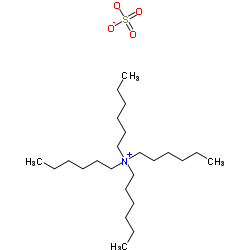tetrahexylammonium sulfate

tetrahexylammonium sulfate structure
|
Common Name | tetrahexylammonium sulfate | ||
|---|---|---|---|---|
| CAS Number | 32503-34-7 | Molecular Weight | 450.740 | |
| Density | N/A | Boiling Point | N/A | |
| Molecular Formula | C24H53NO4S | Melting Point | 98-100 °C(lit.) | |
| MSDS | Chinese USA | Flash Point | N/A | |
| Symbol |

GHS07 |
Signal Word | Warning | |
|
Synthesis and characterization of two novel organic-inorganic compounds based on tetrahexyl and tetraheptyl ammonium ions and the Preyssler anion and their catalytic activities in the synthesis of 4-aminopyrazolo[3,4-d]- pyrimidines.
Molecules 15(4) , 2509-19, (2010) Two novel organic-inorganic compounds based on tetrahexylammonium (THA) and tetraheptylammonium (THPA) ions and the Preyssler anion, [NaP5W30O110]14-, were synthesized and formulated as (THA)7.7H6.3 [NaP5W30O110] (A) and (THPA)7.5 H6.5[NaP5W30O110] (B). The s... |
|
|
beta-Glucuronidase in common duct bile, methodological aspects, variation of pH optima and relation to gallstones.
Scand. J. Clin. Lab. Invest. 57(4) , 307-15, (1997) beta-Glucuronidase of human or bacterial origin may deconjugate bilirubin diglucuronide, causing pigment gallstones. Intrinsic interference by biliary compounds must be minimized for accurate assay of beta-glucuronidase. We report a modified ion-pair extracti... |
|
|
Effects of tetraethylammonium analogs on apoptosis and membrane currents in cultured cortical neurons.
J. Pharmacol. Exp. Ther. 295(2) , 524-30, (2000) Tetraethylammonium (TEA), the quaternary ammonium ion and nonselective K(+) channel blocker, is protective against neuronal apoptosis. We now tested two TEA analogs, tetrapentylammonium (TPeA) and tetrahexylammonium (THA), for their effects on apoptotic neuro... |
|
|
Studies on the formation of hydrophobic ion-pairing complex of alendronate.
Arch. Pharm. Res. 32(7) , 1055-60, (2009) A hydrophobic ion-pairing (HIP) concept considering the high dissociation property of alendronate was used as a strategy to improve the bioavailability of alendronate. Alendronate, which has a negative charge, was ion-paired with organic cations, such as tetr... |
|
|
Efficient extraction of bile acid conjugates with tetraheptylammonium chloride, a liquid ion exchanger.
J. Lipid Res. 8(1) , 55-8, (1967) Ethyl acetate or chloroform solutions of tetraheptylammonium chloride, an oil-soluble quaternary amine, quantitatively extract polar, anionic lipids such as steroid or bile salt conjugates from aqueous solution by a process of anion exchange. |
|
|
The effects of tetrahexylammonium chloride on calcium mobilization from cerebellar microsomes.
Biochem. Soc. Trans. 21(2) , 105S, (1993)
|
|
|
Diuretic screening in human urine by gas chromatography-mass spectrometry: use of a macroreticular acrylic copolymer for the efficient removal of the coextracted phase-transfer reagent after derivatization by direct extractive alkylation.
J. Chromatogr. A. 581(1) , 57-63, (1992) A simple and efficient procedure has been developed for the derivatization of diuretic agents in human urine by direct extractive alkylation and their detection by gas chromatography-mass spectrometry. The procedure is an improvement over previous extractive ... |
|
|
Kinetics and thermodynamics of hexameric capsule formation.
J. Am. Chem. Soc. 126(9) , 2939-43, (2004) Resorcinarene 1b forms a hexameric assembly in water-saturated CDCl(3) that encapsulates one tetraalkylammonium salt (2(+)Br(-)). The remaining space is occupied by coencapsulated solvent molecules. A maximum of three and minimum of one CHCl(3) molecule were ... |
|
|
The interaction of n-tetraalkylammonium compounds with a human organic cation transporter, hOCT1.
J. Pharmacol. Exp. Ther. 288(3) , 1192-8, (1999) Polyspecific organic cation transporters in epithelia play an important role in the elimination of many endogenous bioactive amines and therapeutically important drugs. Recently, the first human organic cation transporter (hOCT1) was cloned from liver. The pu... |
|
|
The application of Fe3O4 nanoparticles in cancer research: a new strategy to inhibit drug resistance.
J. Biomed. Mater. Res. A 80(4) , 852-60, (2007) Although much effort has been extended to the efficient cancer therapies, the drug resistance is still a major obstacle in cancer chemotherapeutic treatments. Almost 90% of the cancer therapy failure is caused by the relative problems. Recently, the applicati... |